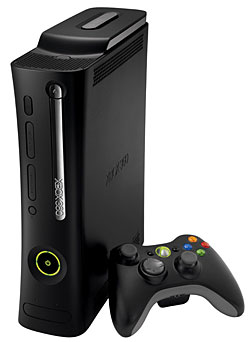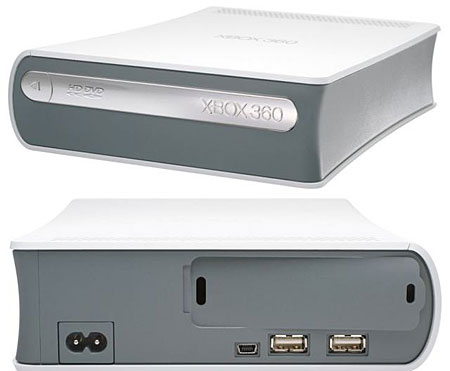Xbox 360 Elite and HD DVD Add-On Drive
 While the VHS vs. Beta battle was fought on the consumer electronics front, that isn't good enough for the 21st Century. In addition to the CE side of the world, the battle for your high-definition dollar is also being waged on the game console front between Sony's PlayStation3 and Microsoft's Xbox 360.
While the VHS vs. Beta battle was fought on the consumer electronics front, that isn't good enough for the 21st Century. In addition to the CE side of the world, the battle for your high-definition dollar is also being waged on the game console front between Sony's PlayStation3 and Microsoft's Xbox 360.
The Xbox 360 has been on the market for nearly two years and has a huge install base of 11 million units worldwide. When the console was launched in November 2005, neither of the HD disc formats had launched, so the 360's disc drive is a standard DVD-ROM. In anticipation for the PS3's release in November of 2006, with its integrated Blu-ray Disc drive, Microsoft surprised the world with the announcement of a HD DVD "add-on" drive enabling the Xbox 360 to become a HD DVD player. Although the 360 add-on drive has been a decent seller (estimates peg US sales alone at 150,000 units sold), this pales in comparison to the estimated 3.5 million PS3s that have been sold in the last eight months worldwide (approximately 1.5 million in the US).
Pound for pound and feature for feature, the PS3 may very well be the best Blu-ray Disc player available on the market today, but the same couldn't be said for the "older" Xbox 360 and the add-on drive. The PS3, while late to the game, came equipped for battle with the addition of a HDMI (1.3) output, wireless networking connectivity, and a sleek form factor. When you compare this to the HDMI-less Xbox 360, Microsoft had to have an answer up its sleeve, and that leads us to the topic of this review: the $479 Xbox 360 Elite with the $199 HD DVD add-on drive.
Back in Black
Ditching the iPod white of the "legacy" 360, Microsoft has changed the color of the new Elite to a matte black, which I much prefer over the original 360. While not as sexy as the PS3, at least this unit looks like it belongs in an AV rack. In response to consumer demand, the Elite also comes equipped with an HDMI output (1.2, with included cable), but beyond this new addition everything else remains the same with the older units. On the back panel, there is a proprietary adapter that breaks out to component and composite video, along with analog stereo and Toslink optical digital audio. Included is a stereo only cable (analog and optical) in case your AVR doesn't have an HDMI input but your display does. There are three USB ports on the unit as well, one in the rear and two hidden behind a "flip-in" panel on the front. Last, included on the back panel is an Ethernet port, but as with all of the other models of the 360, there is no wireless support without purchasing a USB wireless adapter. Rounding out the exterior package is a matching matte black wireless controller and a headset that can be used for online multiplayer games.
The Brains
On the Elite's internals, there are no changes from previous Xbox 360 models, with the exception of the much larger (and removable) 120GB hard drive (the previous model had a 20GB removable hard drive, while the low-priced Xbox Core system doesn't have a hard drive at all). The brain of the unit is a robust 3.2GHz Power PC processor with three dual-threaded processor cores. The graphics are powered by a custom built ATI video board running at 500MHz with 512MB of GDDR3 RAM. For those non-techies out there, the processing is really fast and the graphics look great!
While the specs look outstanding on paper, the implementation has left some things to be desired. After so many complaints levied against the 360 for the heat being generated by its processor and noise coming from the cooling fan, I'm surprised MS didn't address this issue with the release of the Elite console. The CPU cooling fan on the Elite registers 58dB on my SPL meter, an unacceptable noise factor to contend with. While casual viewers may not mind the added noise threshold that the fan adds to the room, I prefer my electronics to be nearly silent so that I can enjoy the movie. The Elite does not offer this type of experience.

Why wasn't the processor upgraded to a cooler running chip? And, if the old chip "had" to be used, why not change the cooling fan to something that doesn't sound like a swamp cooler?
Finally, the DVD drives used in previous 360s have incited complaints by being extremely loud when a disc is in the drive, which is also still the case with the Elite model I reviewed. Granted, it isn't quite as loud as the 360 that I currently own, but it is still much louder than any other disc drive that I have personally used.
HD DVD support
When sitting atop the matte black Elite console, the white HD DVD drive looks like an Oreo cookie that is missing the top, which is to say the package isn't appealing to look at.
Hooking up the add-on drive is a breeze with only a power cord and a USB output that plugs into the USB port on the Elite's rear panel. Don't fret about using (and therefore losing) that USB port though- the add-on drive comes equipped with two additional USB ports on its rear panel. Once plugged in, the Elite had no issues recognizing the HD DVD device.
Also included with the add-on is an IR-controlled universal remote, which is well laid out and can be used in lieu of the game controller to navigate DVD and HD DVD discs. I don't have a love affair with this remote because I found it somewhat sluggish on the response side. But the plus for the Xbox here is that you have the option of using your own Universal IR remote. I programmed my Home Theater Master MX-700 with the proper commands and found that the response was much better than the included remote. This isn't the case with the PS3 because of Sony's use of Bluetooth as the communication method for the PS3. In theory this is very forward thinking and cutting edge, but in reality that choice has alienated a lot of Sony's end users and has limited the functionality of what is otherwise a terrific Blu-ray console.
Setup
Being a previous owner of a Xbox 360, setup was a breeze for me. When you start up the player, which takes about 20 seconds, you are greeted with the clean, clutter-free on-screen dashboard, which allows you to interface with the device. The Dashboard is laid out in tabs labels Xbox Live, Games, Media and System. I immediately went to the System tab and was given the choice to output 480p, 720p, 1080i and 1080p (I chose the latter over HDMI). Next, given choices of Dolby Digital, DTS (1.5 Mbps), or Windows Media Audio (very limited support), I chose DTS as my initial audio option. Once these choices were made, I was ready to rock!
Performance: Video
The first tests I decided to run were in the DVD realm, and I'm sad to report that there have been no improvements here either compared to previous Xbox models. Running through the Silicon Optix HQV Benchmark DVD shows how poorly implemented the DVD playback is on the 360 drive. Neither upconverting DVDs to 1080p nor outputting the discs at 480p made any difference- both were below average. On actual viewing material, I found image very soft and unsatisfying, even for non-critical viewing. The addition of the HDMI output didn't help in this area at all.





























































